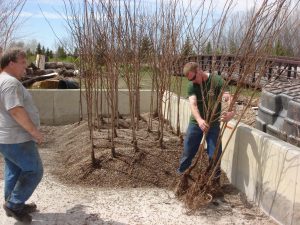Missouri Gravel Bed Project
A Plan to Reforest Our City
This article was taken from the “MN Shade Tree Advocate Newsletter” and written by Derik Olson, MN GreenCorps Member and Urban Forestry Specialist for the City of Rochester.

In Rochester, we have over 30,000 vacant tree planting spaces. Last year we planted 500 trees, and those were just to replace the 1000 that were removed because of poor condition, damage or disease. I think most cities would like to do more, but with one tree costing between $200-300 and more, it is a challenge. This coming spring, we’ll be installing a Missouri Gravel Bed to store bare root trees. By using a Missouri Gravel Bed, we can all afford to have an urban forest that looks like Portland, Oregon, with a well-designed, well-maintained tree canopy.
Conceived by Professor Christopher Starbuck at the University of Missouri in the 1990s, the gravel bed is an effective and efficient way to store bare root trees until they can be planted. This allows cities to purchase quantities of trees (often from out-of-state), and plant them throughout the season. Aside from the convenience, there are many other benefits, the first one being tree mortality reduction. When bare-rooted trees were used in the past, their roots desiccated quickly when exposed to air, wind and sun. The challenge was keeping them alive from the time they arrive until they could be planted. The city of Fargo, ND even went so far as to rent a refrigerated semi-truck trailer, and yet mortality continued. So they installed a gravel bed and mortality dropped to almost zero.
A gravel bed is low-tech. You might even call it Fred Flintstone Forestry. Just a layer of gravel on the ground, about 12 inches deep, and as wide and long as you can afford. Some dig a sunken bed with a ramp for access, and a drain. Some use a concrete or wooden frame. Professor Starbuck has found that adding Calcined Clay (like that used on baseball fields) reduces the amount of watering needed. Some install a drip line for irrigation, while others simply break out the hose once a day to flood the bed. Trees over-winter nicely in the gravel as well, so you can save them for next season. As years go by, the gravel will age and weather and develop more spaces for water to attach itself, further increasing its effectiveness.
Another advantage to bare root in the gravel is after about 4-6 weeks, they develop an incredibly dense root system. Putting a tree in the gravel bed is like a person training for a marathon; you’re getting them in shape for the big event. According to Gary Johnson from the Department of Forest Resources at the University of Minnesota, a tree or shrub held in a gravel bed system for as little as six to eight weeks will have a root system that contains many more fine roots…hundreds to thousands times more fine roots.
With no soil and no pot to mess around with, the trees are easy to transport and plant. This makes it easier for everyone all around, saving time and energy and sweat. So many volunteers have shown up on planting day, worn themselves out moving balled-in-burlap trees around and went home thinking “well, I’ve done that once, and now I think I’m done”, and they don’t volunteer again. Also, when planting a bare root tree, you can see the entire root structure. This allows you to prune out defects and plant it at the correct depth. Crippling Stem-girdling roots are no longer a problem.
Bare root trees generally cost about 1/3 that of container grown or balled in burlap trees, which is the clincher when budgets decide how many trees get planted. Chris Graves, of Whitings Nursery in Rochester explained that nurseries used to sell mostly bare root trees, but that stores like Kmart and Walmart needed to keep trees all year long. So they started wrapping them in Burlap with wire baskets or growing them in large plastic containers. For cities, those methods cost too much and are simply not necessary. I never thought I’d say this, but we can do it cheaper than Walmart.
There’s a general consensus that Emerald Ash Borer will kill a lot of trees in Minnesota in the next 10-50 years, and we’ll have to replace them. Both the DNR and the Forest Service have their respective tree nurseries, but most cities cannot afford to maintain such a facility, so having a gravel bed is the next best thing. Just as every kitchen needs a pantry, every city needs a gravel bed.
Have a comment? Join us on Facebook!